Search results
56 results found.
56 results found.
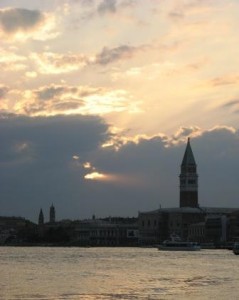

On October 2 at 6:53 PM, the news broke upon an unsuspecting city — and even some unsuspecting city councilors — that the local headmen had cooked up a new scheme: Officially proposing Venice as the site of the 2020 Summer Olympics.
I’ll pause while you adjust your screens.
Technically speaking, “Venice Olympics” wouldn’t necessarily connote the same thing as “Venetian Olympics.”
The “Venetian Olympics” would consist of any typical activity of any typical day in almost any typical week. Medals would be awarded for such events as:
Actually, I think the “Venetian Olympics” could be a spectacular event, for those in the right frame of mind, and best of all, they could be held any day of the year, practically.
But I am only slightly jesting. The headmen, on the other hand, are completely serious. That’s because they are: Massimo Cacciari, the mayor; Giancarlo Galan, governor of the Veneto Region; Franco Manzato, regional vice-president AND councilor for Tourism; and Andrea Tomat, president of Confindustria Veneto, the regional business association. Politicians and businessmen — it’s the winning team in most Olympic efforts, I have no doubt. And as soon as Madrid lost its bid to Rio, thereby re-opening the field to a European candidate for the next go-round, Venice pounced.

But “Venice Olympics” is a loss leader. What they mean by “Venice Olympics” translates into “Olympics scattered around the Veneto region.” Everybody wants to get into the act.
The only foreseeable competitor in Italy would be Rome, which hosted the Games in 1960 (perhaps a handicap, though capital cities seem to do well). I”m not sure what card Rome will be playing in an attempt to become the national candidate, but it’s true that they wouldn’t have to face the quips that almost certainly will soon be lobbed at Venice. I can imagine the helpful suggestions for organizing the pole vault over the campanile of San Marco; synchronized swimming in the Grand Canal; the hammer throw and shot-put aimed at the taxis churning along the Giudecca Canal. Field hockey in the Piazza San Marco.
Let me not blemish the euphoria by mentioning crass numbers; clearly the visions of new everything being built all across the region has got lots of people all worked up. I merely mention, at random, that the candidacy of Madrid, which made it all the way to the finals, cost the equivalent of $55 million.
And that’s just the cost of candidacy. Once you nab the Games, the real bills start to mount up. Brazil has budgeted $14 billion to host the Games in Rio. Venice has a few handicaps, in my opinion, in that regard: It’s already the most expensive city in Italy (this ought to really lure spectators), and it has made a career of rattling its tin cup, wailing that it has no money. But… but… If there is no money for schools, monument restoration, policemen, hospitals, firemen, and so on, how can they suddenly find millions — gosh, it was right here behind the Encyclopedia Britannica all the time — and be prepared to expend billions, if they get the nod? (That was a rhetorical question.)
The notables who have spoken have been refreshingly direct about why they want the Olympics. Skipping entirely any mention, however brief, of desiring to add to the glory of Italy, or the honor of the city, or the splendor of our athletes (somebody did refer to that, I think, but I can’t see how that matters), they’ve gone right to the point.
“Promoting and organizing the Games of 2020 would permit the city and the entire metropolitan area represented by the triangle of Venice, Padua and Treviso (italics mine) to accelerate the numerous improvement and renewal projects which for years have filled the agendas of the institutions of the territory,” said Mayor Cacciari.
“Venezia 2020 represents a strategic project for the development of the infrastructure of the entire Region,” said Dr. Galan. For the record, the entire Region covers about 7,000 square miles.
“Our businesses realize that having the Olympic Games in Venice in 2020 could act as a catalyst for a series of ‘virtuous’ processes in the economic field and help the consumer regain confidence,” said President Tomat.
But don’t break out the Prosecco just yet. First of all, Rome isn’t going to shrink from the fight — au contraire. This was the home of the gladiators, after all; also, the mayor of Rome belongs to the right wing of the political spectrum, while the mayor of Venice is from the left. They’re used to fighting. So, like every war, this brewing conflict has a long history and many undetected combatants.
And a few cautious voices — important voices — have sounded their notes of warning amid the chorus of praise for this audacious notion.
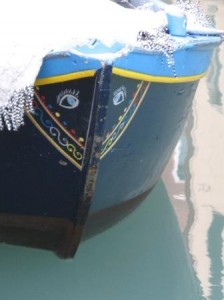
“Extremely important economic guarantees are going to be needed,” commented the head of the Italian Olympic Committee (CONI), the group which will adjudicate which city carries Italy’s banner into the final selection. Not a very heartening public statement, though unusually honest. They were polite enough not to refer to the recently (finally) completed Ponte della Costituzione (“the Calatrava Bridge”), which required 11 years, many lawsuits and an impressive cost overrun (final cost: $18 million compared to the $10 million quoted in the winning bid), to span 265 feet of the Grand Canal. But an Olympic Stadium ought to be a lot simpler.
“It would undoubtedly be a great opportunity for the entire Veneto [there we go again] to furnish itself with facilities adequate to such an event which would then remain at the disposition of local groups….It would require an enormous investment with the complete participation of the government as well as the industial sector,” remarked Renzo Di Antonio, president of the Olympic Committee’s Veneto division.
“As a Venetian I couldn’t be anything other than happy at this proposal,” said Andrea Cipressa, fencing gold medalist and vice-president of the national fencing association. “Naturally, on the real feasibility of the project I feel some understandable doubts….There are many, many things to take into consideration and the first impact of the proposal is mainly emotional, romantic. But then you have to start taking reality into account as well as the many problems which are always connected with Venice.”
But perhaps he has failed to grasp the magnitude of the marvels which the Olympics would bestow on the Region (excuse me: ENTIRE Region], especially right around Venice, innovations which have already been discussed for quite a while in the government:
“I believe that Tessera” (the village near the airport) “has all the necessary potential,” said Laura Fincato, councilor for Urban Planning. “We are discussing an area which would have a multilateral potential — an area of recreation including a new building for the Casino, a stadium, a concert hall and an structure for all sorts of sports. In this area there is also the airport and the [future] passage of the high-speed railway [the TAV Corridor 5 which will connect Kiev to Lisbon, passing through northern Italy]. If we then add a forest of 105 hectares [260 acres], it seems to me that we have all the right conditions.” A forest?? Now that’s something that’s really been missing from the urban fabric. We don’t have enough firemen — we don’t even have a breakdown lane on the Liberty Bridge. But a forest by the airport? Why didn’t anybody think of that before?
The mayor of the nearby beach resort of Jesolo is already jumping up and down and waving his hand: “We could hold the windsurf and beach volley competitions,” is his contribution to the discussion.
Paradoxically, though, the rowing competitions would be impossible to hold in the lagoon, due to the tidal currents. Sailing in the Adriatic ought to work, but rowing would have to be somewhere else. That’s going to be a little tricky for the public relations work. Maybe they could dig the rowing basin in the forest by the airport.
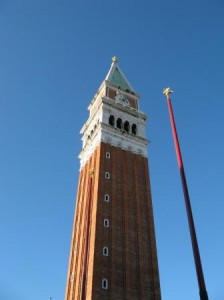
One commentator, Tiziano Graziottin, sees the big picture this way: “However you look at it, there are many obstacles on the horizon to overcome; the ‘tripartisan’ group put into play by Cacciari, Galan and Manzato… looks at Venice as the figurehead of an entire Veneto system, using the icon of the most beautiful city in the world to fascinate world public opinion while aiming at developing the potential of an entire macro-region… Venice is the star that drives photographers crazy but the Olympic ‘film’ succeeds only if all the actors play their part under the highest-quality direction…. The good thing about this idea is the concept behind it, and it’s a key concept for ‘internal use’: To make clear to a public opinion frequently divided into provincial (in every sense) rivalries that Venice and the Veneto can and must march together.” For those numbed by the endless bickering between Dr. Cacciari (center-left) and Dr. Galan (center-right), this is a revolution. “Bipartisan” isn’t a word you hear used very much; in Italian, it’s a knobby little word (bipartitico) which doesn’t really have a home in anyone’s vocabulary. I think it must sleep in the political garage.
A closing note — more like a shot across the bow — from the ever-contrarian lawyer, Francesco Mario D’Elia, who has organized four (4) referendums with the aim of separating Venice from Mestre, all of which failed, but not by so much. He has now organized a committee called “No to the Venice 2020 Olympics.”
“To propose Venice for the Olympics,” he stated, “is merely an operation involving the image, in order to exploit the fame of the city without giving anything in return…. Therefore we say ‘Enough’ to those who exploit the name of Venice, a city which has no need of the Olympics.”
So he has wasted no time in writing to the governor of the Region of Sicily saying that there’s a small group in Venice ready to support their candidacy for the Olympics, presumably at Palermo. “The Palermo Olympics.” That sounds even stranger than The Venice Olympics.
In all, a fairly audacious gamble, which will require betting millions of somebody’s money to play a hand which may not turn out to be as strong as its holder might imagine. Venice isn’t in the habit of competing, really — people come here anyway, whether you invite them or not. As a historic, artistic and even touristic city, who would it compete against? So having to think as a global competitor for anything is going to be a short sharp shock to a few people here. Especially when they come up against other potential candidates such as Cape Town and Mumbai and St. Petersburg.
But that’s the point of gambling — you’re ready to take a chance. Perhaps it will turn out that this whole Venice Olympics business is going to be less like a game of poker or mah-jongg and more like a long and unfathomably expensive session of “Risk.”
My earlier post about Race Day as a whole didn’t say anything about what I was doing while the world was ending for some of the racers.
I can tell you what I wasn’t doing: Screaming my lungs out for the Vignottini, which would have been ridiculous considering that they were already five car-lengths in the lead. No danger of anything rear-ending them last Sunday if they’d come to a sudden stop. I felt cheated, somehow. I fully intended to be screaming. Never mind. Life will probably provide another opportunity for screamage.
What the Storica means for us at the club — and it’s more or less like this every year except this year it was even better than usual — is the following:
Saturday morning: Whoever is free comes to titivate their boat. There was a small chain gang working on the caorlina, and an even smaller one (including me) working on the gondolone. We had to sandpaper and polish all the brass, including the big ornamental ferri of the prow and the bow. Lino and Lucio worked at nailing and screwing down various bits that had gone adrift over the months, and then there was varnishing the whole thing. She is now a dazzling vision of delight, and will remain so for, oh, maybe a month. It depends on the weather how fast the brass will lose its luster.
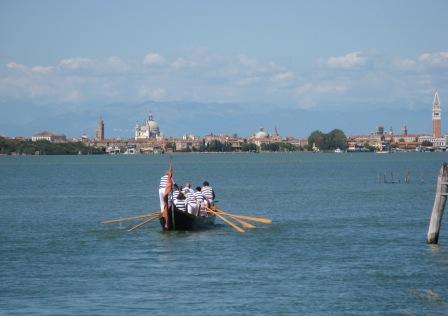
At 2:00 we dressed in our club best — blue and white tank top and white skirt (women), white pants for the men. Lino was dressed in his judge’s outfit, as he was on duty for two of the four races.
We rowed across the lagoon with some breeze but not too much. We crossed the Bacino of San Marco (waves, as always, but not as bad as usual because the traffic is limited this afternoon) and dropped Lino near San Marco, where he went to join the rest of his merry band of judges at the Tourism Office (regata division).
We rowed around the Bacino for a little while until it was time for the corteo, or boat procession, to form up. There is no real Italian way to express the concept of “forming up,” as the concept doesn’t exist. I’m not sure there is even anything close that you could compare it to, in order to explain to someone here what it might involve, or why it might matter. They’d just give you that “Well you’re perfectly welcome to try it if you want to but don’t get me involved” look.
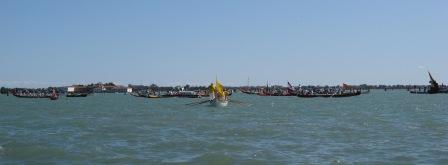
Each boat has a number on its bow which indicates its order in the lineup. The number’s only discernible use is to help the speaker on the reviewing stand (the “Machina,” MAH-keen-ah) to identify the particular organization the boat belongs to as it drifts past. That part actually works pretty well.
We had number 11 and were probably two-thirds of the way back when the thing got going. You ask why we were so far back? Because the corteo wranglers had given absolutely no signal of any kind to indicate the imminent departure of said corteo. Evidently order isn’t foremost on their list of concerns either.
So we rowed in a slow and stately way up the Grand Canal (sometimes I surprise myself, at how normal doing something like that has come to be — then I suddenly snap to and think, Holy Crap! This is incredible!). The first regatas that might correspond somewhat to the current “regata storica” were arguably the series of races organized in January 1315 by doge Giovanni Soranzo. (In the 19th century it was called the “regata reale,” or royal regata). The corteo was added to the program much, much later, to evoke the arrival in Venice in 1489 of Caterina Cornaro, a Venetian noblewoman who was briefly also queen of Cyprus. It’s as good an excuse as any to add just that much more glamour — or glitter or marabou or whatever looks good — to the event.
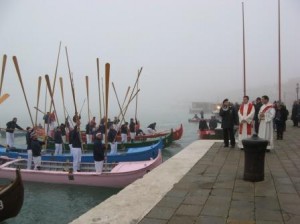
At certain points along the route we perform an alzaremi, or oar-raising, the classic Venetian waterborne ceremonial salute which looks thrilling. Too bad it’s been done to death by now. Lino thinks it should be limited to very few and very important moments, and I agree. But on this occasion, there are clumps of people all along the way who yell “alzaremi” at every boat just so they can snap a picture. It’s just one of the many, many ways in which a person here begins to be made to feel like a walk-on in somebody else’s entertainment.
But the sun is shining, there is music playing over lots of loudspeakers, people are leaning out of palace windows everywhere taking it all in, and it’s all just too splendid for words.
Then we turn around — I remember when we used to go as far as the train station, but every year people tend to break ranks and turn around sooner. There are some reasons for this, one of which, I think, has to do with resisting the idea of being compelled to perform for other people’s entertainment. That’s my theory. At least I resist that idea.
So we find a good place to park, as close to the finish line near the San Toma’ vaporetto stop as we can manage (on the shady, not the sunny side), and we tie up the boat. We pull out the vittles — cookies, tiny pizzas, peanuts, squares of homemade cake, fruit, etc. — and beverages, which are wine, water, and fruit juice. Very important, beverages. The heat can trick you and the one thing you don’t want to be in a boat is thirsty.
There’s another thing you don’t want to be in a boat, and we bring a small bucket for that. Nobody has ever had to use it.
This event used to have a dramatically different aspect. For decades, Lino would come early in the afternoon in his own little boat — as most people did — find a good place to tie up, and then eat and drink all afternoon, sharing with his neighbors, clambering over boats to go visit friends, and so on — much like the Redentore, but with races instead of fireworks.
In those days, the corteo consisted only of the bissone, or fancy ceremonial barges, and a long procession of black gondolas carrying every authority figure within reach — mayor, councilors, presidents of things, even the President of Italy on occasion. Then came the year when the Italian Prime Minister, Amintore Fanfani, had the misfortune of being rowed up the Grand Canal to the jeering shouts of a doggerel rhyme that works very well in Venetian (Fanfani! Fanfani! Ti ga i morti cani!). This is one of the absolutely worst insults in the Venetian universe and it basically means that your deceased relatives are dogs. I don’t think you have to speak Venetian to understand that it’s not your day.
This happened about 1976, as Lino recalls. Not long thereafter, the political party in power shifted to the Communist party and that sort of thing wasn’t tolerated at all. To make sure it didn’t happen by mistake, they just stopped sending their authority figures.
At the same time, after the first Vogalonga in 1975, there was a boom in new boat clubs, so the corteo began to be generally populated by boats like ours. civilians from rowing clubs who may also be tempted to shout rude things at each other, but it doesn’t make any difference when they do it. Since I’ve been here I’ve never seen a gondola with an official or notable aboard — just tourists, or paid costumed walk-ons.
Furthermore, for most of the “Storica”‘s history there was only one race: The gondolini. The races for women, boys, and men on the caorlinas were added gradually over the same mid-Seventies period. If you had to do triage and get rid of any races, I can tell you the only one they’d try to save would be the gondolini. Although the other ones are very nice.
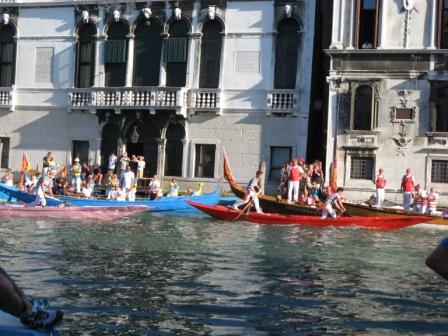
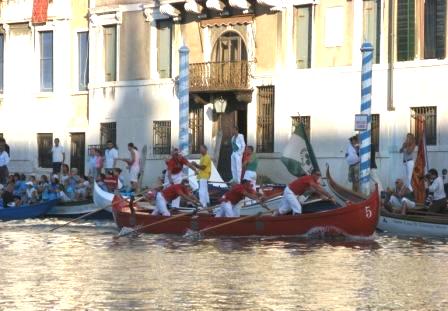
The most serious change in the past 20, or even 15, years is the steady decline in spectator boats. As I mentioned, Lino could climb over boats from hither to farther than yon all afternoon, but each year fewer Venetians come in boats to witness what was once one of their central events of the year. Even I have noticed the diminution of number of boats watching. There are many reasons for this but one of the primary ones is that the regata, on the whole, has been reshaped for tourists, either on land or watching TV, and therefore (for reasons I’ll spare you) it’s less interesting to be a participant. And the increase in motorboats has fatally weakened what was once a common language and connection with boats that are rowed.
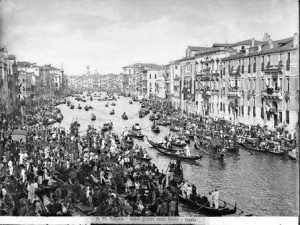
From being a crucial element of daily life for everyone, rowing has become a sort of boutique activity whose appeal is probably stronger as a picturesque curiosity to non-Venetians than to most locals, especially the younger ones.
Back to us. So we spend the afternoon hanging around watching the races and screaming if we should feel the need to for whoever our favorite racer(s) might be — and there have been times I have screamed so hard that I probably blew out some synapses, mine as well as the people nearest to me. I know the racers can’t hear me, but I also know they would notice if my voice weren’t in there somewhere. I know this. It’s a mystic racing thing.
As soon as the gondolini have crossed the finish line, everybody starts to leave. Instantly. Imagine everybody after the game trying to get out of the stadium parking lot at the same time. Lots of motors (not everybody who comes rows here anymore, unfortunately), and lots of motor-revving and choking exhaust fumes from these lovers of the oar.
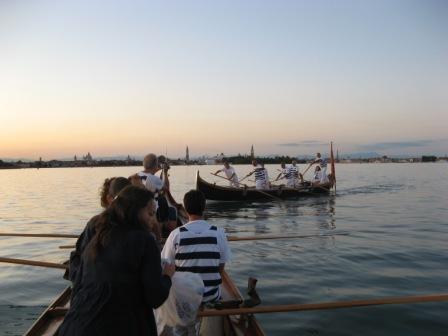
Now comes almost the best part of all, which is the row back to the club. This takes about an hour because we’re not in a hurry; the sun is setting — it’s after 7:00 PM now — and the lagoon is calm and everyone is feeling happy and relaxed and it’s just one of the loveliest rowing interludes in the entire year.
We always stop, not far from the club, to open a bottle of wine (okay, two) and just sit and savor the moment out in the water all by ourselves. This year it was even sweeter than usual. The caorlina was not far behind us, and so we waited and then we tied the two boats together and just let the day and the moment and the sunset and the calm seep all the way through us.
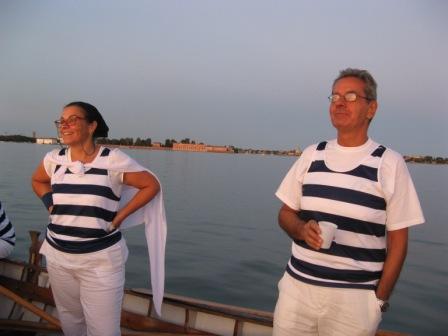
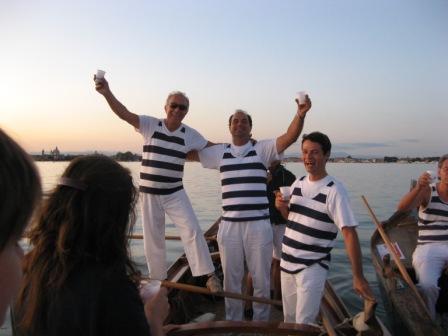
The moon, enormous and shining and orange, rose slowly above the treetops on the Lido. It was so beautiful it verged on the preposterous; Italians say that something like this, the final perfect touch, is the “cherry on the cake.” It was actually the moon on the cake. I’m sticking with that, at least I know what I mean.
The corteo is very nice, of course. But it’s something thousands of people (80,000 this year, by police estimates) can see, and anything that imitates something that once was genuine can hardly compare with something that is completely genuine right now. The corteo was a sort of imitation, but this was really ours. There were very, very few people who saw the lagoon as we did in the twilight with evening breath drifting around us and the moon’s radiance blooming out of the sky.
It all belonged to us and it needed no spectators or commentators. What a beautiful thing that is in this world, and how rare.

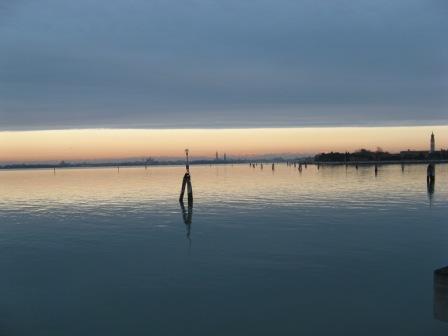
The daily cri di coeur (that would make a great newspaper name) comes via the Gazzettino from Paolo Lanapoppi, a Venetian and former president of an association called Pax in Aqua, about which much more some other time.
Lanapoppi felt compelled to write to the Gazzettino, even as the wind whistled through the windmills toward which he was spurring his horse, so to speak, to take issue with the latest jab which mayor Massimo Cacciari had made to the few remaining morons who insist on living in his city and dare to criticize its administration.
A day or so earlier, Mr. Cacciari had brushed aside a discouraging word from some constituent with the brusque observation that Venetians are “piangnoni” (crybabies, kvetchers, whiners) and Mr. Lanapoppi sees it quite differently. I’m translating his missive here not because I want to spoil your day, as I know you have problems of your own to think about, but because it summarizes very eloquently some basic points which deserve to be criticized here, and why.
Venetians are crybabies? Who has governed the city since 1993? We need a new governing class (August 27, 2009)
It seems incredible. As the number of residents continues to fall and the city is clogging up with vacation rooms for rent, trash in the shop windows, tourist launches, day-trippers, the mayor is declaring that the city needs to free itself from the monoculture of tourism. He even goes so far as to say that Venetians have to stop being crybabies.
But who governed the city from 1993 to 2000? Cacciari. And from 2000 to 2005? Paolo Costa, elected with the support of Cacciari. And from 2005 till today? Cacciari again, naturally.
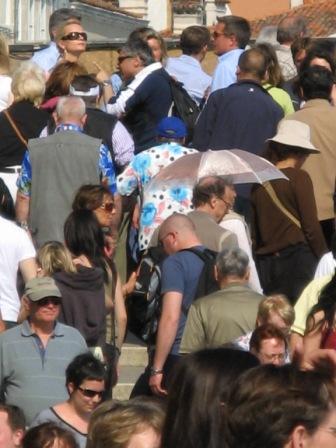
So who is supposed to be battling the monoculture of tourism? The opposition? Or the elderly in their nursing homes? Or we members of a thousand organizations which fight every day to have a little space in the newspapers to denounce an unsustainable situation, and that find ourselves at thousands of conferences and round tables being snubbed by the administrators?
So to the damage they’re now adding mockery: we’re being accused of being snivelers. Instead, there’s Cacciari fighting the tourism monoculture, inaugurating new museums as if they were for the 60,000 residents, who inaugurates new piers as if they were nursery schools for the Venetians, who sets up a brand-new dock for the tourist launches in the Riva dei Sette Martiri, who ignores and lets languish an area of tremendous potential like the waterfront in Marghera, who has not succeeded in many years to create even one great center for research or for work, who goes to the Biennale and the Film Festival to do “culture,” who sells the facades of the palaces under restoration for publicity.
One sees the desire to get out of the tourism monoculture, one sees it clearly. All you have to do is look at what the Cacciari government is doing.
Then, on the same day, the vice-mayor, Michele Vianello, comes out with an incredible quip: To put an end to the motondoso in the Bacino of San Marco, what we need is a single authority. That he would have the courage to say so after five years of the commissioner (N.B.: against motondoso, as well as mayor) Costa would be amazing if it weren’t offensive to the intelligence of his listeners. Because there’s something else that is needed: What’s needed are people in power who have the capacity and the will to make changes. Venice — and notable people such as Riccardo Calimani, Francesco Giavazzi, Gherardo Ortalli, have said it unanimously and in public — has not been capable of producing a class of governors worthy of its history and its potential.
It has been, at the most, a springboard for launching people who are seeking national notoriety; meanwhile, the city is crumbling under the suction of the propellors (another reference to motondoso) and is being transformed by the pressure of 20 million voracious grasshoppers (tourists) a year. As for the future, one hears predictions of 40 million in another 20 years. We’re already preparing the hotels of the future Tessera City (the village near the airport) and the under-lagoon subway to facilitate their arrival.
Nice way to get out of the monoculture of tourism.
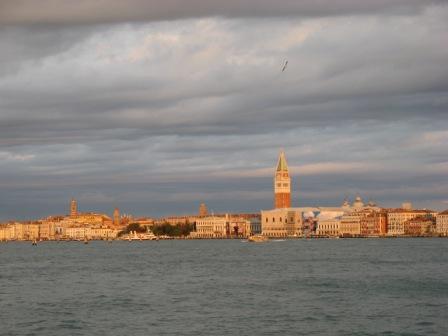
There’s so much to say about tourism in Venice I’ll have to go in easy stages, filling many pages and posts. Let’s start with last weekend, which demonstrated the rough outlines of what the term “tourism” can mean here.
The first of May is a holiday in much of Europe, its version of Labor Day in which we celebrate workers and excoriate employers.
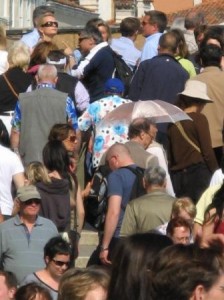
Nothing quite so simple anymore as sending armies and tanks marching across Red Square; this year saw mass demonstrations of angry workers (and ex-workers) in Greece, France, Turkey, Spain, and Germany, and even Russia, which once reveled more in its military parades than rallies of irate trade unions.
Here in Venice, it was just another day in the march of money, and in fact there are plenty of days you could label “mayday mayday,” when holidaying legions of tourists from all over Europe march across the city. So far this year the Horde-Meter has registered Carnival, followed by Easter weekend, then by April 25 (which fell on a weekend this year), and finally May 1.
There were roughly 60,000 tourists per day, instantly doubling the city’s population, shuffling along the narrow streets, overwhelming the Piazza San Marco, and turning the vaporettos (when and if you finally managed to get on one) into something from the Pushkar Camel Fair. Hundreds of tourist coaches unleashed their day-tripping multitudes onto a city whose only public space, the Piazza San Marco, is 320 times smaller than Red Square. Let’s put it another way: The Piazza covers 255 square meters, and crowd-density experts estimate that one square meter can reasonably (we’ll leave some latitude for what that means) hold 3-4 people. That means that ideally there would be no more than 1,000 people in the Piazza at any given time. Let’s say that the crowds peak at noon, and let’s say that that amounts to 40,000 people. Or even 30,000, half the daily total. Or even 20,000, one-third the daily total. Numbers aren’t my strongest point but I think I could already have guessed that there might be as much as 20 times more people in the Piazza than would be pleasant.
The ACTV added three runs per hour to its already heavy Grand Canal vaporetto schedule (reaching a total of 37 extra runs), as well as nine extra runs to Murano and Burano and 13 extra back to Venice. But it’s never enough, in the sense that “enough” would mean no waiting, no crushing, no delays. 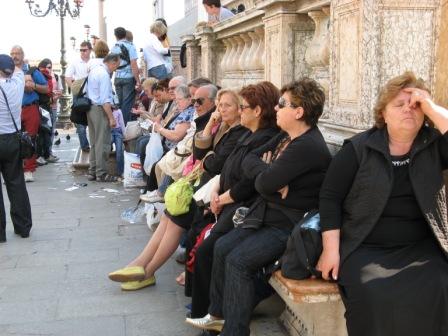 It would be an impressive spiritual exercise for anyone wanting to determine how much compassion they can feel toward their fellow humans to board the #1 local vaporetto line at Piazzale Roma on any Mayday (which amounts to virtually any day from May 1 to September 1) with their soul full of love for humankind, and then measure what’s left by the time they reach San Marco.
It would be an impressive spiritual exercise for anyone wanting to determine how much compassion they can feel toward their fellow humans to board the #1 local vaporetto line at Piazzale Roma on any Mayday (which amounts to virtually any day from May 1 to September 1) with their soul full of love for humankind, and then measure what’s left by the time they reach San Marco.
If you look at tourism in Venice in strictly logistical terms, you can see that it’s a fascinating little problem, which so far has defeated solution. There are approximations of functionality (more vaporettos), but essentially there is no way in which a city which covers only three square miles can prevent or neutralize the stress caused by this particular kind of mass demonstration. It can only be minimized, sort of.
I spent an hour in the Piazza and I came away with one unexpected insight: It’s entirely possible that the gondoliers at the two “stations” (stazi) there were not born crazy. I’ve always wondered about that. I believe it’s likely that they have been made to go crazy by too many days like this. And don’t think all these tourists represent wallets on the hoof. An inverse ratio between quantity and quality has been noticed by almost everyone, something I’ll go into on another occasion.
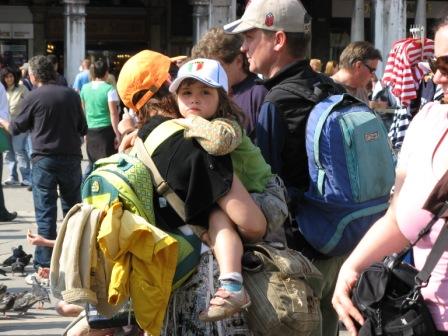 Me, I have no idea how much money you would have to pay me — in cash, even — to go to San Marco on a holiday weekend, at least any later than 7:00 AM. I need to protect what little sanity I have left.
Me, I have no idea how much money you would have to pay me — in cash, even — to go to San Marco on a holiday weekend, at least any later than 7:00 AM. I need to protect what little sanity I have left.